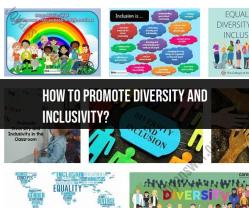Does diversity training actually work?
Diversity training has become a prominent tool for organizations striving to build inclusive workplaces and address issues related to bias and discrimination. However, the effectiveness of such training programs has been a subject of debate. In this article, we delve into the question: Does diversity training truly work, and if so, what are the factors that determine its efficacy?
Defining Success Metrics:
- Clarity of Objectives: To determine the effectiveness of diversity training, organizations must first establish clear objectives and success metrics. These objectives could include reducing biases, increasing inclusivity, improving workplace relationships, or enhancing employee satisfaction.
Content Relevance and Customization:
Tailored Content: The effectiveness of diversity training is often linked to the relevance of the content. Training should be customized to address the specific challenges and needs of the organization. A one-size-fits-all approach is less likely to yield positive results.
Cultural Sensitivity: Training content should be culturally sensitive and consider the diverse backgrounds and identities of the participants.
Experienced Facilitators:
Skilled Facilitators: The competence and experience of the facilitators play a critical role. Skilled trainers can create a safe and engaging learning environment, facilitate discussions effectively, and navigate potentially challenging conversations.
Diverse Facilitators: Having a diverse group of facilitators can provide a broader range of perspectives and enhance the training's impact.
Interactive Learning:
- Active Engagement: Interactive elements such as group discussions, case studies, and role-playing exercises help participants engage actively with the content. Such activities can promote empathy, self-awareness, and skill-building.
Psychological Safety:
Creating Safe Spaces: An environment of psychological safety, where participants feel comfortable sharing their thoughts and experiences, is crucial. Fear of judgment or retaliation can hinder the effectiveness of diversity training.
Ground Rules: Establish ground rules for respectful and constructive discussions.
Follow-Up and Application:
Reinforcement: To assess the long-term impact, organizations should implement follow-up activities and continuous learning opportunities. Diversity training should be seen as a journey, not a one-time event.
Action Plans: Encourage participants to develop action plans for applying what they've learned in their daily work. This helps translate knowledge into actionable change.
Measurement and Evaluation:
Metrics and Assessments: Organizations should use quantitative and qualitative assessments to measure the training's impact. These metrics could include changes in employee behavior, reductions in reported bias incidents, or improvements in diversity-related key performance indicators.
Feedback Mechanisms: Establish feedback mechanisms for participants to provide input on the training's effectiveness and suggest improvements.
Accountability and Leadership:
Leadership Commitment: The commitment of organizational leaders to diversity and inclusion initiatives is vital. Leadership should champion these efforts, hold themselves accountable, and lead by example.
Accountability Measures: Establish mechanisms to hold individuals and teams accountable for promoting diversity and inclusion in their respective roles.
The efficacy of diversity training depends on various factors, including the clarity of objectives, customized content, skilled facilitation, interactivity, psychological safety, follow-up, measurement, and leadership commitment. While diversity training can be an essential tool in fostering inclusivity, it is not a standalone solution. It should be integrated into a broader diversity and inclusion strategy that includes ongoing efforts, policies, and cultural changes. Ultimately, the success of diversity training is not solely about whether it "works," but rather how it contributes to creating a more inclusive and equitable organizational culture.







